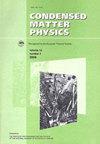Path integral Monte Carlo simulations of the geometrical effects in KDP crystals
IF 1
4区 物理与天体物理
Q4 PHYSICS, CONDENSED MATTER
引用次数: 0
Abstract
Path integral Monte Carlo (PIMC) simulations with very simple models were used in order to unveil the physics behind the isotope effects in H-bonded ferroelectrics. First, we studied geometrical effects in the H-bonds caused by deuteration with a general three-site model based on a back-to-back double Morse potential plus a Morse potential between oxygens, fitted to explain different general features for a wide set of H-bonded compounds. Our model results show the Ubbelohde or geometrical effect (GE), i.e., the expansion of the H-bond with deuteration, in agreement to what is observed in H-bonded ferroelectrics with short H-bonds. Moreover, adjusting the potential parameters to ab initio results, we have developed a 1D model which considers the bilinear proton-proton interaction in mean-field to study nuclear quantum effects that give rise to the GE in KDP crystals. PIMC simulations reveal that protons tunnel more efficiently than deuterons along the 1D chain, giving rise to a strong attraction center that pulls the oxygens together. This mechanism, which is based on the correlation between tunneling and geometrial modifications of the H-bonds, leads to a strong GE in the ordered phase of the chain at low temperature which is in good agreement with the experimental data.KDP晶体几何效应的路径积分蒙特卡罗模拟
为了揭示氢键铁电体中同位素效应背后的物理原理,采用了路径积分蒙特卡罗(PIMC)模拟方法。首先,我们研究了氘化引起的氢键几何效应,采用了一个基于连续双摩尔斯电势和氧之间的摩尔斯电势的通用三位点模型,该模型适用于解释广泛的氢键化合物的不同一般特征。我们的模型结果显示了ubbelode或几何效应(GE),即氢键与氘化的膨胀,与在具有短氢键的氢键铁电体中观察到的一致。此外,我们将势参数调整为从头计算结果,建立了一个考虑平均场双线性质子-质子相互作用的一维模型,以研究导致KDP晶体中GE的核量子效应。PIMC模拟显示,质子在一维链上的隧道比氘核更有效,产生了一个强大的吸引中心,将氧聚集在一起。这一机制是基于氢键的隧道效应和几何修饰之间的关系,在低温下导致链的有序相有很强的GE,这与实验数据吻合得很好。
本文章由计算机程序翻译,如有差异,请以英文原文为准。
求助全文
约1分钟内获得全文
求助全文
来源期刊

Condensed Matter Physics
物理-物理:凝聚态物理
CiteScore
1.10
自引率
16.70%
发文量
17
审稿时长
1 months
期刊介绍:
Condensed Matter Physics contains original and review articles in the field of statistical mechanics and thermodynamics of equilibrium and nonequilibrium processes, relativistic mechanics of interacting particle systems.The main attention is paid to physics of solid, liquid and amorphous systems, phase equilibria and phase transitions, thermal, structural, electric, magnetic and optical properties of condensed matter. Condensed Matter Physics is published quarterly.
 求助内容:
求助内容: 应助结果提醒方式:
应助结果提醒方式:


